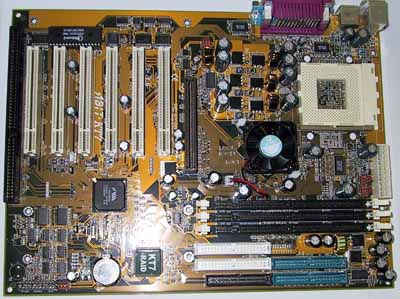ABIT KT7-RAID Socket-A KT133 ATX
by Anand Lal Shimpi on August 12, 2000 1:01 AM EST- Posted in
- Motherboards
Four months ago we introduced the ABIT KA7 with the not so attractive opener of "Honestly speaking, ABIT is far from the best motherboard manufacturer worldwide." Contrary to what that first sentence may imply, the rest of the review was the first in quite a while that actually placed ABIT in a favorable light. Being ABIT's first ever Athlon motherboard (they didn't produce an AMD 750 based solution), the KA7 was such a great motherboard that we even placed it on the same platform as the ASUS K7V.
Was the KA7 a fluke from ABIT? Prior to its release we had been less than satisfied by the stability and added features that were found in ABIT's flagship boards, but the KA7 changed our perception of the company back to what it once was.
Following our excellent experience with the KA7, ABIT impressed us yet again with their BX133-RAID, a grand farewell to the BX chipset from ABIT, one of its biggest supporters.
What made the KA7 and the BX133-RAID both knockouts while most of the boards prior to them were mostly disappointing? They both made a return to ABIT's roots, what made them the name they are today. They both boasted innovative features, such as the KA7's flexible SoftMenu III setup and the BX133-RAID's solid 133MHz FSB & IDE RAID support and were very stable solutions.
ABIT has continued their recent return to tradition with their first entry into the Socket-A/KT133 arena, the KT7-RAID. Since their first entry into the Slot-A market was an instant hit, it isn't unbelievable that its successor would at least equal it in shock value at least, we didn't expect it to surpass it however.
|
ABIT KT7-RAID |
|
|
CPU Interface
|
Socket-A
|
|
Chipset
|
VIA KT133
|
|
Form Factor
|
ATX
|
|
Bus Speeds
|
100
- 183MHz (1MHz increments)
|
|
Voltages Supported
|
1.30 - 2.05V in 0.05V increments
|
|
Memory Slots
|
3 168-pin DIMM Slots
|
|
Expansion Slots
|
1 AGP Slot
6 PCI Slots (4 Full Length) 1 ISA Slot (Shared) |
|
On-board Audio
|
N/A
|
|
BIOS
|
Award Modular BIOS 6.00PG
ABIT SoftMenu III |
The Good
The KA7 joined the ranks of the ASUS K7V, AOpen AK72, EPoX 7KXA and Tyan Trinity K7 as another quite large Slot-A motherboard upon its release. Maybe it was the fact that a slot-based CPU interface leaves quite a bit of room seemingly unoccupied around it (for heatsink clearance), but looking at the KT7-RAID's layout you quickly notice that the design is much more "busy" than its predecessor.
Like the BX133-RAID was to the BX6/BH6 series of motherboards, the KT7-RAID marks ABIT's departure from the Slot-A based Athlon interface to the 462-pin Socket-A interface of the new Athlons (Thunderbirds) and Durons. The move to a socket based CPU interface forced ABIT to completely redesign the layout of the upper right area of the motherboard. The Socket-A interface is pushed to the very edge of the motherboard, and the required capacitors/inductors/voltage regulators are positioned directly to the left of the socket.
The ATX power supply connector is placed where it should be, at the very right edge of the motherboard, allowing you to minimize the distance you have to stretch the ATX power cable from your PSU, thus decreasing the number of obstructions in your case that would decrease airflow.
Speaking of airflow., there is quite a bit of it that is generated over the VIA 371 North Bridge present just south of the CPU socket courtesy of the heatsink/fan ABIT placed on the chip. While we never noticed any instability that was caused by the lack of a fan on the chip, ABIT did much more than simply stick a fan on the heatsink to make the board look "cool."
For starters, you have to remember that on Slot-A motherboards there is normally airflow. going over the heatsink of the North Bridge since the heatsink/fan combo of your Slot-A processor is normally hanging over the chip. This airflow. is not present on a Socket-A design such as the ABIT KT7-RAID. While this still doesn't mean that active cooling is necessary, it is nice to know that ABIT didn't simply glue a heatsink onto the North Bridge, they used thermal compound to attach the heatsink/fan unit to the chip which helps to improve heat transfer between the chip and the heatsink. Because of the price point of the KT7-RAID, and the fact that many users would like to run the more cost effective Duron processors on the board, we would've rather had ABIT leave out the fan if it did in fact drop the retail price of the motherboard since there isn't really a need for it although it doesn't hurt to have.











0 Comments
View All Comments